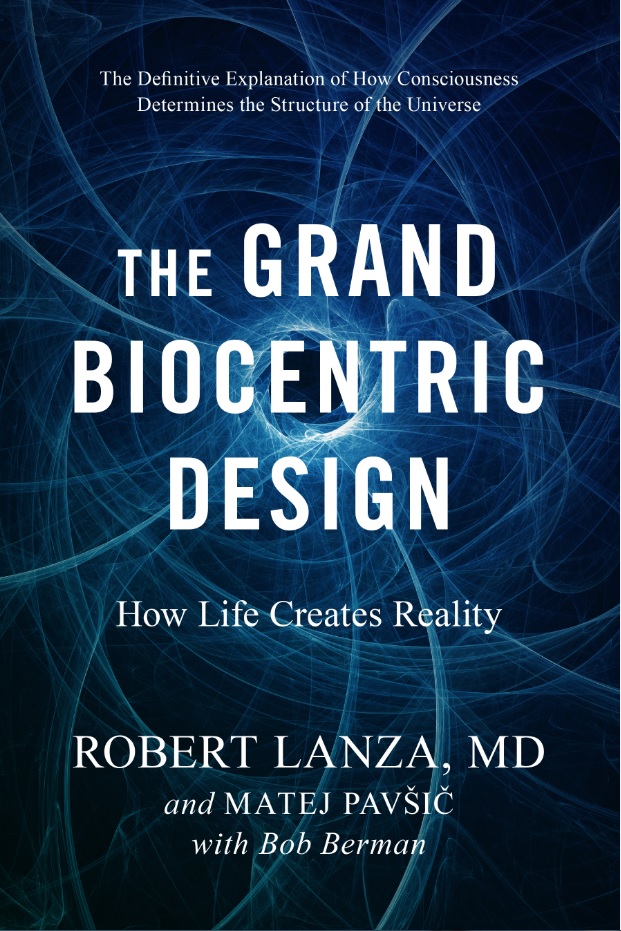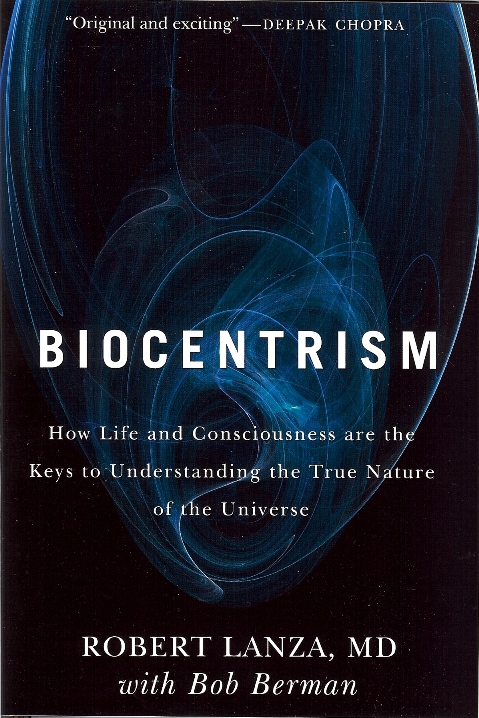
After the death of his old friend, Albert Einstein said “Now Besso has departed from this strange world a little ahead of me. That means nothing. People like us … know that the distinction between past, present and future is only a stubbornly persistent illusion.”
New evidence continues to suggest that Einstein was right – death is an illusion.
Our classical way of thinking is based on the belief that the world has an objective observer-independent existence. But a long list of experiments shows just the opposite. We think life is just the activity of carbon and an admixture of molecules – we live awhile and then rot into the ground.
We believe in death because we’ve been taught we die. Also, of course, because we associate ourselves with our body and we know bodies die. End of story. But biocentrism – a new theory of everything – tells us death may not be the terminal event we think. Amazingly, if you add life and consciousness to the equation, you can explain some of the biggest puzzles of science. For instance, it becomes clear why space and time – and even the properties of matter itself – depend on the observer. It also becomes clear why the laws, forces, and constants of the universe appear to be exquisitely fine-tuned for the existence of life.
Until we recognize the universe in our heads, attempts to understand reality will remain a road to nowhere.
Consider the weather ‘outside’: You see a blue sky, but the cells in your brain could be changed so the sky looks green or red. In fact, with a little genetic engineering we could probably make everything that is red vibrate or make a noise, or even make you want to have sex like with some birds. You think its bright out, but your brain circuits could be changed so it looks dark out. You think it feels hot and humid, but to a tropical frog it would feel cold and dry. This logic applies to virtually everything. Bottom line: What you see could not be present without your consciousness.
In truth, you can’t see anything through the bone that surrounds your brain. Your eyes are not portals to the world. Everything you see and experience right now – even your body – is a whirl of information occurring in your mind. According to biocentrism, space and time aren’t the hard, cold objects we think. Wave your hand through the air – if you take everything away, what’s left? Nothing. The same thing applies for time. Space and time are simply the tools for putting everything together.
Consider the famous two-slit experiment. When scientists watch a particle pass through two slits in a barrier, the particle behaves like a bullet and goes through one slit or the other. But if you don’t watch, it acts like a wave and can go through both slits at the same time. So how can a particle change its behavior depending on whether you watch it or not? The answer is simple – reality is a process that involves your consciousness.
Or consider Heisenberg’s famous uncertainty principle. If there is really a world out there with particles just bouncing around, then we should be able to measure all their properties. But you can’t. For instance, a particle’s exact location and momentum can’t be known at the same time. So why should it matter to a particle what you decide to measure? And how can pairs of entangled particles be instantaneously connected on opposite sides of the galaxy as if space and time don’t exist? Again, the answer is simple: because they’re not just ‘out there’ – space and time are simply tools of our mind.
Death doesn’t exist in a timeless, spaceless world. Immortality doesn’t mean a perpetual existence in time, but resides outside of time altogether.
Our linear way of thinking about time is also inconsistent with another series of experiments. In 2002, scientists showed that particles of light “photons” knew – in advance – what their distant twins would do in the future. They tested the communication between pairs of photons. They let one photon finish its journey – it had to decide whether to be either a wave or a particle. Researchers stretched the distance the other photon took to reach its own detector. However, they could add a scrambler to prevent it from collapsing into a particle. Somehow, the first particle knew what the researcher was going to do before it happened – and across distances instantaneously as if there were no space or time between them. They decide not to become particles before their twin even encounters the scrambler. It doesn’t matter how we set up the experiment. Our mind and its knowledge is the only thing that determines how they behave. Experiments consistently confirm these observer-dependent effects.
Bizarre? Consider another experiment that was published in the prestigious scientific journal Science (Jacques et al, 315, 966, 2007). Scientists in France shot photons into an apparatus, and showed that what they did could retroactively change something that had already happened in the past. As the photons passed a fork in the apparatus, they had to decide whether to behave like particles or waves when they hit a beam splitter. Later on – well after the photons passed the fork – the experimenter could randomly switch a second beam splitter on and off. It turns out that what the observer decided at that point, determined what the particle actually did at the fork in the past. At that moment, the experimenter chose his past.
Of course, we live in the same world. But critics claim this behavior is limited to the microscopic world. But this ‘two-world’ view (that is, one set of physical laws for small objects, and another for the rest of the universe including us) has no basis in reason and is being challenged in laboratories around the world. From 1997 to 2020, experiments have consistently shown that quantum behavior extends into the everyday realm. For example, Physicist Nicolas Gisin sent entangled particles zooming along optical fibers until they were seven miles apart. But whatever action they took, the communication between them happened instantaneously (“spooky action at a distance,” as Einstein put it). Today no one doubts the connectedness between bits of light or matter. They’re intimately linked in a manner suggesting there’s no space between them, and no time influencing their behavior. In fact, in 2012, researchers published a paper in Nature (Yin et al, 488, 185) extending this distance to unprecedented lengths—they achieved quantum teleportation across Qinghai Lake in China, a distance roughly equivalent to the distance between New York City and Philadelphia. Other experiments with huge molecules called ‘Buckyballs’ also show that quantum reality extends beyond the microscopic world. And in 2005, KHC03 crystals exhibited entanglement ridges one-half inch high, quantum behavior nudging into the ordinary world of human-scale objects.
We generally reject the multiple universes of Star Trek as fiction, but it turns out there is more than a morsel of scientific truth to this popular genre. One well-known aspect of quantum physics is that observations can’t be predicted absolutely. Instead, there is a range of possible observations each with a different probability. One mainstream explanation, the “many-worlds” interpretation, states that each of these possible observations corresponds to a different universe (the ‘multiverse’). There are an infinite number of universes and everything that could possibly happen occurs in some universe. Death does not exist in any real sense in these scenarios. All possible universes exist simultaneously, regardless of what happens in any of them.
Life is an adventure that transcends our ordinary linear way of thinking. When we die, we do so not in the random billiard-ball-matrix but in the inescapable-life-matrix. Life has a non-linear dimensionality – it’s like a perennial flower that returns to bloom in the multiverse.
“The influences of the senses,” said Ralph Waldo Emerson “has in most men overpowered the mind to the degree that the walls of space and time have come to look solid, real and insurmountable; and to speak with levity of these limits in the world is the sign of insanity.”
Robert Lanza has published extensively in leading scientific journals. His new book “The Grand Biocentric Design” lays out a comprehensive scientific argument for his theory of everything.
The Most Amazing Experiment
From Biocentrism (Robert Lanza and Bob Berman)
Quantum theory has unfortunately become a catch-all phrase for trying to prove various kinds of New Age nonsense. It’s unlikely that the authors of the many books making wacky claims of time-travel or mind-control, and who use quantum theory as “proof,” have the slightest knowledge of physics or could explain even the rudiments of QT. The popular 2004 film, What the Bleep Do We Know? is a good case in point. The movie starts out claiming quantum theory has revolutionized our thinking – which is true enough – but then, without explanation or elaboration, goes on to say that it proves people can travel into the past or “choose which reality you want.”
QT says no such thing. QT deals with probabilities, and the likely places particles may appear, and likely actions they will take. And while, as we shall see, bits of light and matter do indeed change behavior depending on whether they are being observed, and measured particles do indeed appear to amazingly influence the past behavior of other particles, this does not in any way mean that humans can travel into their past or influence their own history.
Given the widespread generic use of QT, plus the paradigm-changing tenets of biocentrism, using QT as evidence might raise eyebrows among the skeptical. For this reason, it’s important that readers have some genuine understanding of QT’s actual experiments — and can grasp the real results rather than the preposterous claims so often associated with it. For those with a little patience, this chapter can provide a life-altering understanding of the latest version of one of the most famous and amazing experiments in the history of physics.
The astonishing “double-slit” experiment, which has changed our view of the universe – and serves to support biocentrism — has been performed repeatedly for many decades. This specific version summarizes an experiment published in Physical Review A, (65, 033818) in 2002. But it’s really merely another variation, a tweak to a demonstration that has been performed again and again for three quarters of a century.
It all really started early in the 20th century when physicists were still struggling with a very old question – whether light is made of particles called photons, or whether instead they are waves of energy. Isaac Newton believed “particles.” But by the late 19th century, waves seemed more reasonable. In those early days, some physicists presciently and correctly thought that even solid objects might have a “wave nature” as well.
To find out, we use a source of either light or particles. In the classic double-slit experiment, the particles are usually electrons, since they are small, fundamental (they can’t be divided into anything else) and easy to beam at a distant target. A classic TV set, for example, directs electrons at the screen. We start by aiming light at a detector wall. First, however, the light must pass through an initial barrier with two holes. We can shoot a flood of light or just a single indivisible photon at a time – the results remain the same. Each bit of light has a 50-50 change of going through the right or the left slit. After awhile, all these photon-bullets will logically create a pattern – falling preferentially in the middle of the detector with fewer on the fringes, since most paths from the light source go more-or-less straight ahead. The laws of probability say that we should see a cluster of hits like this:

When plotted on a graph (in which number of hits is vertical, and position on the detector screen horizontal) the expected result for a barrage of particles is to indeed have more hits in the middle and fewer near the edges, which produces a curve like this:

But that’s not the result we actually get. When experiments like this are performed – and they have been done thousands of times during the past century – we find that the bits of light instead create a curious pattern:

Plotted on a graph, the pattern’s “hits” look like this:

In theory, those smaller side peaks around the main one should be symmetrical. In practice, we’re dealing with probabilities and individual bits of light, so the result usually deviates a bit from the ideal. Anyway, the big question here is: Why this pattern?
Turns out, it’s exactly what we’d expect if light is made of waves, not particles. Waves collide and interfere with each other, causing ripples. If you toss two pebbles into a pond at the same time, the waves of each meet each other and produce places of higher-than-normal, or lower-than-normal water-rises. Some waves reinforce each other, or, if one’s crest meets another’s trough, they cancel out at that spot.
So this early 20th-century result of an interference pattern, which can only be caused by waves, showed physicists that light is a wave, or at least acts that way when this experiment is performed. The fascinating thing is that when solid physical bodies like electrons were used, they got exactly the same result. Solid particles have a wave-nature too! So, right from the get-go, the double slit experiment yielded amazing information about the nature of reality. Solid objects have a wave nature!
Unfortunately, or fortunately, this was just the appetizer. Few realized that true strangeness was only beginning. The first oddity happens when just one just photon or electron is allowed to fly through the apparatus at a time. After enough have gone through and been individually detected, this same interference pattern emerges. But how can this be? With what is each of those electrons or photons interfering? How can we get an interference pattern when there’s only indivisible object in there at a time?

A single photon hits the detector.
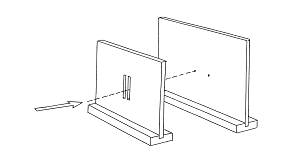
A second photon hits the detector.

A third photon hits the detector.

Somehow, these individual photons add up to an interference pattern!
There has never been a truly satisfactory answer for this. Wild ideas keep emerging. Could there be other electrons or photons “next door” in a parallel universe, from another experimenter doing the same thing? Could their electrons be interfering with ours? That’s so far-fetched, few believe it.
The usual interpretation of why we see an interference pattern is that photons or electrons have two choices when they encounter the double slit. They do not actually exist as real entities in real places until they are observed, and they aren’t observed until they hit the final detection barrier. So when they reach the slits, they exercise their probabilistic freedom of taking both choices. Even though actual electrons or photons are indivisible, and never split themselves under any conditions whatsoever, their existence as “probability waves” are another story. Thus, what goes “through the slit” are not actual entities but just probabilities. . THE PROBABILITY WAVES OF THE INDIVIDUAL PHOTONS INTERFERE WITH THEMSELVES! When enough have gone through, we see the overall interference pattern as all probabilities congeal into actual entities making impacts and being observed – as waves.
Sure it’s weird, but this, apparently, is how reality works. And this is just the very beginning of Quantum Weirdness. QT, as we mentioned last chapter, has a principle called complementarity which says that we can observe objects to be one thing or another – or have one position or property or another, but never both. It depends on what one is looking for, and what measuring equipment is used.
Now, suppose we wish to know which slit a given electron or photon has gone through, on its way to the barrier. It’s a fair enough question, and it’s easy enough to find out. We can use polarized light (meaning light whose waves vibrate either horizontally or vertically or else slowly rotate their orientation) and when such a mixture is used, we get the same result as before. But now let’s determine which slit each photon is going through. Many different things have been used, but in this experiment we’ll use a “quarter wave plate” in front of each slit. Each quarter wave plate alters the polarity of the light in a specific way. The detector can let us know the polarity of the incoming photon. So by noting the polarity of the photon when it’s detected, we know which slit it went through.

Now we repeat the experiment, shooting photons through the slits one at a time, except this time we know which slot each photon goes through. Now the results dramatically change. Even though QWPs do not alter photons except for harmlessly shifting their polarities (later we prove that this change in results is not caused by the QWPs), now we no longer get the interference pattern. Now the curve suddenly changes to what we’d expect if the photons were particles:

Something’s happened. Turns out, the mere act of measurement, of learning the path of each photon, destroyed the photon’s freedom to remain blurry and undefined and take both paths until it reached the barriers. Its “wave function” must have collapsed at our measuring device, the QWPs, as it instantly “chose” to become a particle and go through one slit or the other. Its wave nature was lost as soon as it lost its blurry probabilistic not-quite-real state. But why should the photon have chosen to collapse its wave-function? How did it know that we, the observer, could learn which slit it went through?
Countless attempts to get around this, by the greatest minds of the past century, have all failed. Our knowledge of the photon or electron path alone caused it to become a definite entity ahead of the previous time. Of course physicists also wondered whether this bizarre behavior might be caused by some interaction between the “which-way” QWP detector or various other devices that have been tried, and the photon. But no. Totally different which-way detectors have been built, none of which in any way disturbs the photon. Yet we always lose the interference pattern. The bottom line conclusion, reached after many years, is that it’s simply not possible to gain which-way information and the interference pattern caused by energy-waves.
We’re back to QT’s complementarity – that you can measure and learn just one of a pair of characteristics, but never both at the same time. If you fully learn about one, you will know nothing about the other. And just in case you’re suspicious of the quarter wave plates, let it be said when used in all other contexts, including double slit experiments but without information-providing polarization-detecting barriers at the end, the mere act of changing a photon’s polarization never has the slightest effect on the creation of an interference pattern.
Okay, let’s try something else. In nature, as we saw in the last chapter, there are “entangled particles” or bits of light (or matter) that were born together and therefore “share a wave function” according to QT. They can fly apart – even across the width of the galaxy – and yet they still retain this connection, this knowledge of each other. If one is meddled with in any way so that it loses its “anything’s possible” nature and has to instantly decide to materialize with, say, a vertical polarization, its twin will instantaneously then materialize too, and with a horizontal polarity. If one becomes an electron with an up spin, the twin will too, but with a down spin. They’re eternally linked in a complementary way.
So now let’s use a device which shoots off entangled twins in different directions. Experimenters can create the entangled photons by using a special crystal called beta-barium borate (BBO). Inside the crystal, an energetic violet photon from a laser is converted to two red photons, each with half the energy (twice the wavelength) of the original, so there’s no net gain or loss of energy. The two outbound entangled photons are sent off in different directions. We’ll call their paths direction p and s.
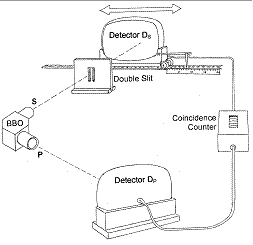
We’ll set up our original experiment with no which-way information measured. Except now, we add a “coincidence counter.” The role of the coincidence counter is to prevent us from learning the polarity of the photons at detector S unless a photon also hits detector P. One twin goes through the slits (call this photon s) while the other merely barrels ahead to a second detector. Only when both detectors register hits at about the same time do we know that both twins have completed their journeys. Only then does something register on our equipment. The resulting pattern at detector S is our familiar interference pattern:
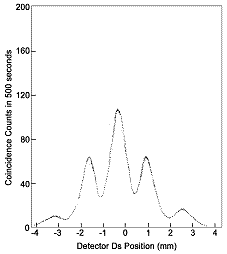
This makes sense. We haven’t learned which slit any particular photon or electron has taken. So the objects have remained probability waves.
But let’s now get tricky. First we’ll restore those QWPs so we can get which-way information for photons traveling along path S.
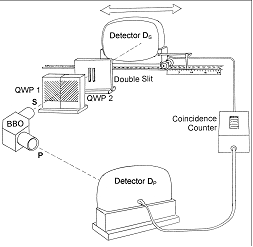
As expected, the interference pattern now vanishes, replaced with the particle pattern, the single curve.
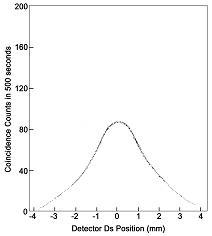
So far so good. But now let’s destroy our ability to measure the which-way paths of the s photons, but without interfering with them in any way. We can do this by placing a polarizing window in the path of the other photon P, far away. This plate will stop the second detector from registering coincidences. It’ll measure only some of the photons, and effectively scramble up the double-signals. Since a coincidence-counter is essential here in delivering information about the completion of the twins’ journeys, it has now been rendered thoroughly unreliable. The entire apparatus will now be uselessly unable to let us learn which slit individual photons take when they travel along path S because we won’t be able to compare them with their twins – since nothing registers unless the coincidence counter allows it to. And let’s be clear: We’ve left the QWPs in place for photon S. All we’ve done is to meddle with the p photon’s path in a way that removes our ability to use the coincidence counter to gain which-way knowledge. (The set-up, to review, delivers information to us, registers “hits,” only when polarity is measured at detector S AND the coincidence counter tells us that either a matching or non-matching polarity has been simultaneously registered by the twin photon at detector P). The result:
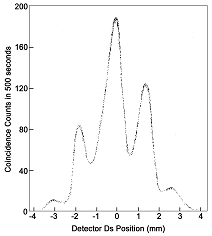
They’re waves again. The interference pattern is back. The physical places on the back screen where the photons or electrons taking path s hit have now changed. Yet we did nothing to these photons’ paths, from their creation at the crystal all the way to the final detector. We even left the QWPs in place. All we did was meddle with the twin photon far away so that it destroyed our ability to learn information. The only change was in our minds. How could photons taking path S possibly know that we put that other polarizer in place — somewhere else, far from their own paths? And QT tells us that we’d get this same result even if we placed the information-ruiner at the other end of the universe.
(Also, by the way, this proves that it wasn’t those QWP plates that were causing the photons to change from waves to particles, and to alter the impact points on the detector. We now get an interference pattern even with the QWPs in place. It’s our knowledge alone that the photons or electrons seem concerned about. This alone influences their actions.)
Okay, this is bizarre. Yet these results happen every time, without fail. They’re telling us that an observer determines physical behavior of “external” objects. Could it get any weirder? Hold on: Now we’ll try something even more radical – an experiment only first performed in 2002. Thus far the experiment involved erasing the which-way information by meddling with the path of p and then measuring its twin s. Perhaps some sort of communication takes place between photon p and s, letting s know what we will learn, and therefore giving it the green light to be a particle or a wave and either create or not create an interference pattern. Maybe when photon p meets the polarizer it sends s an IM (instant message) at infinite speed, so that photon s knows it must materialize into a real entity instantly, which has to be a particle since only particles can go through one slit or the other and not both. Result: No interference pattern.
To check out whether this is so, we’ll do one more thing. First we’ll stretch out the distance p photons have to take until they reach their detector, so it’ll take them more time to get there. This way, photons taking the S route will hit their own detectors first. But oddly enough, the results do not change! When we insert the QWPs to path S the fringes are gone; and when we insert the polarizing scrambler to path P and lose the coincidence-measuring ability that lets us determine which-way info for the S photons, the fringes return as before. But how can this be? Photons taking the S-path already finished their journeys. They either went through one or the other slit, or both. They either collapsed their “wave function” and became a particle or they didn’t. The game’s over, the action’s finished. They’ve each already hit the final barrier and were detected – before twin p encountered the polarizing scrambling device that would rob us of which-way information.
The photons somehow know whether or not we will gain the which-way information in the future. They decide not to collapse into particles before their distant twins even encounter our scrambler. (If we take away the P scrambler, the S photons suddenly revert to being particles, again before P’s photons reach their detector and activate the coincidence counter.) Somehow, photon s knows whether the “which-way” marker will be erased even though neither it, nor its twin, have yet encountered an erasing mechanism. It knows when its interference behavior can be present, when it can safely remain in its fuzzy both-slits ghost reality, because it apparently knows photon p — far off in the distance — is going to eventually hit the scrambler, and that this will ultimately prevent us from learning which way p went.
It doesn’t matter how we set up the experiment. Our mind and its knowledge or lack of it is the only thing that determines how these bits of light or matter behave. It forces us, too, to wonder about space and time. Can either be real if the twins act on information before it happens, and across distances instantaneously as if there is no separation between them?
Again and again, observations have consistently confirmed the observer-dependent effects of QT. In the past decade, physicists at the National Institute of Standards and Technology have carried out an experiment that, in the quantum world, is equivalent to demonstrating that a watched pot doesn’t boil. “It seems,” said Peter Coveney, a researcher there, “that the act of looking at an atom prevents it from changing.” (Theoretically, if a nuclear bomb were watched intently enough, it would not explode, that is, if you could keep checking its atoms every million trillionth of a second. This is yet another experiment that supports the theory that the structure of the physical world, and of small units of matter and energy in particular, are influenced by human observation.)
In the last couple of decades, quantum theorists have shown, in principle, that an atom cannot change its energy state as long as it is being continuously observed. So, now, to test this concept, the group of laser experimentalists at the NIST held a cluster of positively charged beryllium ions, the “water” so to speak, in a fixed position using a magnetic field, the “kettle”. They applied “heat” to the kettle in the form of a radio-frequency field that would boost the atoms from a lower to a higher energy state. This transition generally takes about a quarter of a second. However, when the researchers kept checking the atoms every four milliseconds with a brief pulse of light from a laser, the atoms never made it to the higher energy state, despite the force driving them toward it. It would seem that the process of measurement gives the atoms “a little nudge,” forcing them back down to the lower energy state–in effect, resetting the system to zero. This behavior has no analog in the classical world of everyday sense awareness and is apparently a function of observation.
Arcane? Bizarre? It’s hard to believe such effects are real. It’s a fantastic result. When quantum physics was in its early days of discovery in the beginning of the last century, even some physicists dismissed the experimental findings as impossible or improbable. It is curious to recall Albert Einstein’s reaction to the experiments: “I know this business is free of contradictions, yet in my view it contains a certain unreasonableness.”
It was only with the advent of quantum physics and the fall of objectivity, that scientists began to consider again the old question of the possibility of comprehending the world as a form of mind. Einstein, on a walk from The Institute for Advanced Study at Princeton to his home on Mercer street, illustrated his continued fascination and skepticism about an objective external reality, when he asked Abraham Pais if he really believed that the moon existed only if he looked at it. Since that time, physicists have analyzed and revised their equations in a vain attempt to arrive at a statement of natural laws that in no way depends on the circumstances of the observer. Indeed, Eugene Wigner, one of the 20th century’s greatest physicists, stated that it is “not possible to formulate the laws of [physics] in a fully consistent way without reference to the consciousness [of the observer].” So when quantum theory implies that consciousness must exist, it tacitly shows that the content of the mind is the ultimate reality, and that only an act of observation can confer shape and form to reality– from a dandelion in a meadow, to sun, wind and rain.


